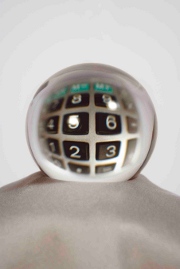A magazine where the digital world meets the real world.
On the web
- Home
- Browse by date
- Browse by topic
- Enter the maze
- Follow our blog
- Follow us on Twitter
- Resources for teachers
- Subscribe
In print
What is cs4fn?
- About us
- Contact us
- Partners
- Privacy and cookies
- Copyright and contributions
- Links to other fun sites
- Complete our questionnaire, give us feedback
Search:
A Street magic stunt: Quick think of a number

Street magicians like David Blaine often use this psychological trick. Ask your friend to quickly think of a two-digit number between 1 and 100, both digits odd and both digits different from each other. Concentrate, the answer is ... 37!
Magic: the statistical "37" number force trick
First up, this trick doesn't always work! Of course in the TV shows they only show the time it did work! It's based on probability and a rather sneaky way of reducing your spectator's choice. If it goes wrong for you, Hey it's mind reading, it's supposed to be hard. You were just not tuned in properly.
How does it work?
You start with saying they can choose any two-digit number between 1 and 100 (they will remember you giving them that 1-100 choice. It's called the primacy effect in memory: you tend to remember the things at the start better). Two digits means 1-9 are eliminated instantly.
You then go on to say both digits must be odd, so that halves the possible numbers too: all the even ones. Next, you say both digits must be different. This narrows it down even more. There are in fact very few numbers left that the spectator can choose from (though they don't tend to notice this).
This is where the psychology and statistics comes in. When asked to give the number quickly the vast majority of people will say 37. It may be that it's somewhere in the middle. 13 would be too small, 97 would be too big. It may be that the numbers 3 and 7, which themselves are the most common answers if you ask people to name a number between 1 and 10, just seem to come together. Whatever the reason there is an increased chance that you get the 37 you want.
Psychology, bias and cognitive science
This effect of most people choosing 37 is called a psychological bias. Another example would be to ask someone to quickly think of a colour. Most people answer RED... Or a vegetable - most say carrot. Understanding human psychology, such as the primacy effect in memory and psychological biases used in this trick, is a part of cognitive science. It is a fascinating new field where we try to understand the process of human thinking. COmputer Scientists then use the results to try, for example, to build easier to use software, or build artificial intelligences with human-like abilities.
So the next time you think of 37, think of the cognitive science behind it, then choose the number 57 (or perhaps you did already!)


